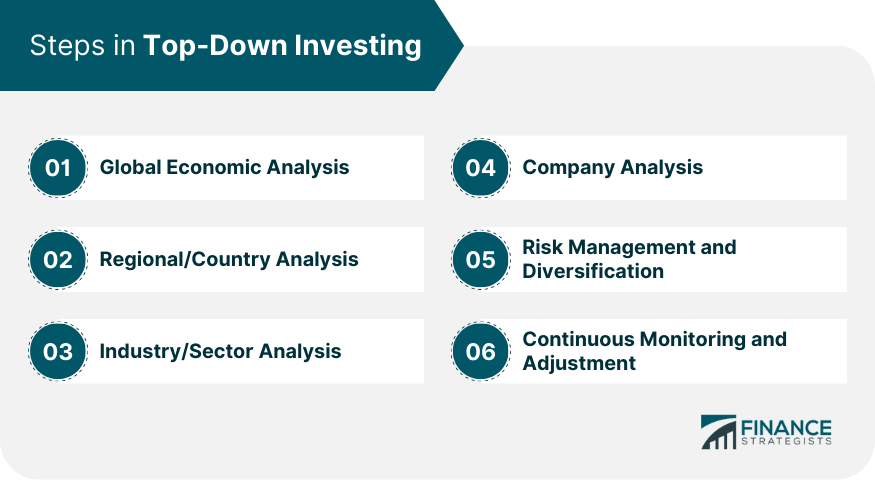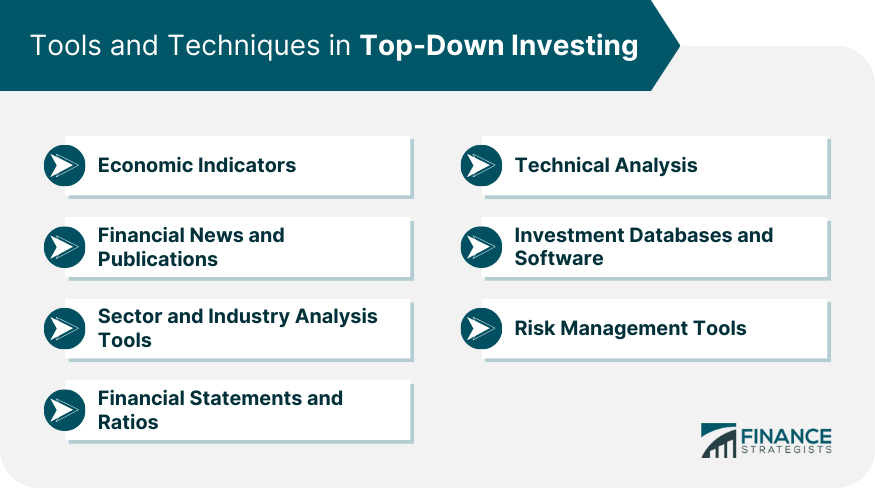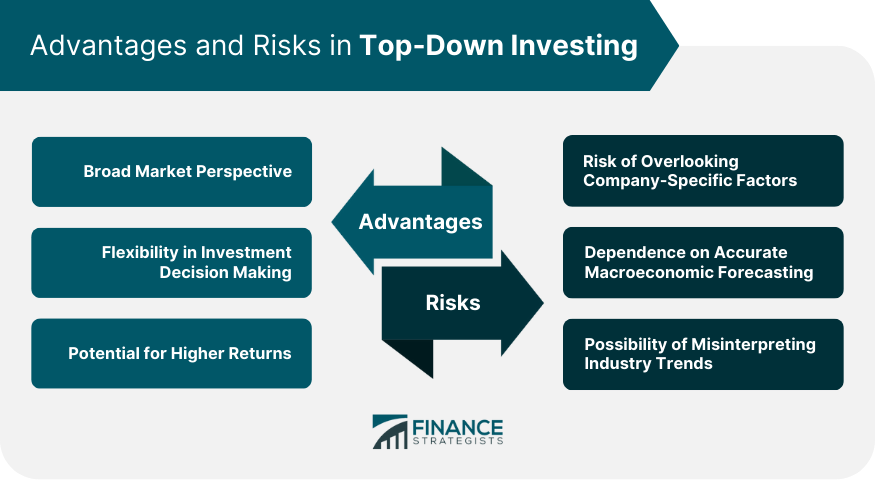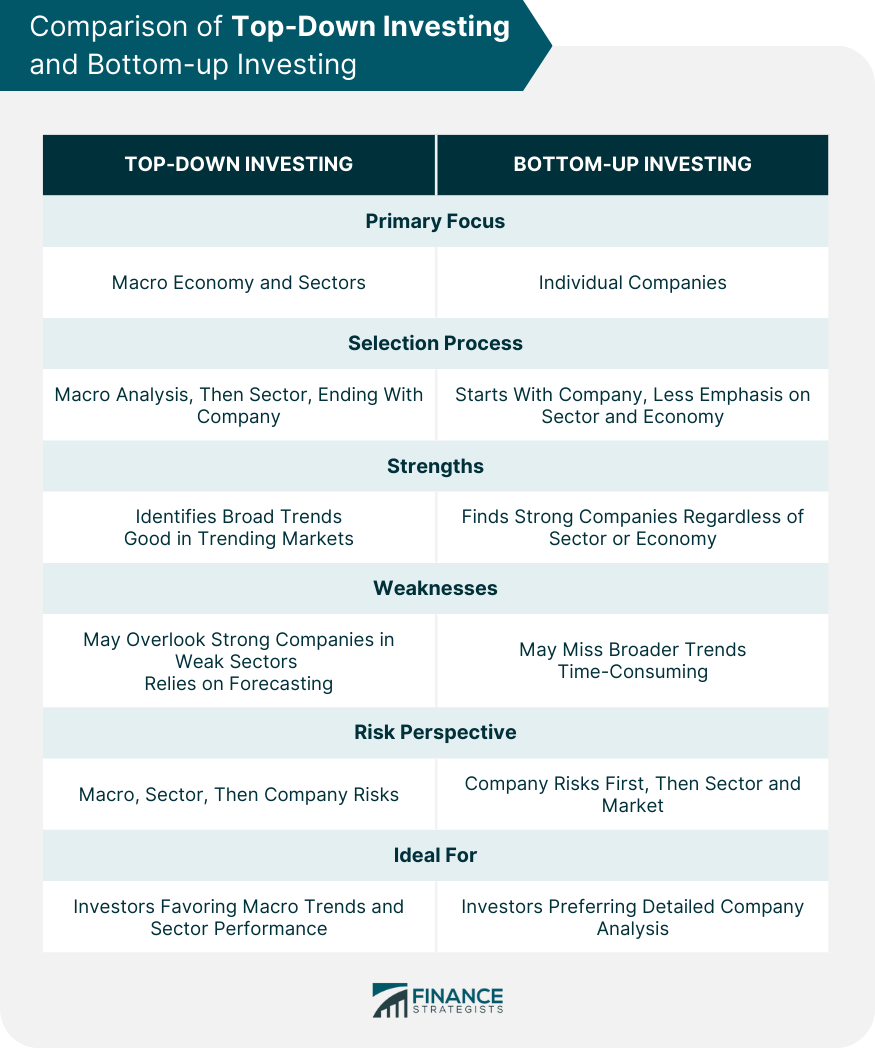Top-down investing is a strategy that starts with an overview of global macroeconomic trends before focusing on specific sectors, industries, and individual companies. The methodology begins with the largest possible scope—the global economy—and gradually refines its focus to the smallest detail—an individual company's financials. Historically, the top-down investing approach became popular during the post-World War II era, particularly during rapid globalization and economic interconnectivity. Investors recognized that a company's performance could no longer be understood in isolation from the broader economic context, both domestically and globally. Top-down investing is a crucial strategy for investors who want to ensure their portfolio aligns with the bigger picture of the global economy. This strategy aids in identifying sectors and industries poised to outperform in the current and anticipated macroeconomic climate. Top-down investing is an investment analysis approach that primarily considers macroeconomic factors when making investment decisions. The process starts from the top (the broadest perspective) and goes down to individual stocks or bonds. This is the first step in the top-down investment strategy, where investors analyze the global economy. Investors may consider factors like global growth rates, trends in globalization, international trade and relations, geopolitical risks, and international monetary policies. Once a macroeconomic perspective is established, investors identify regions or countries expected to outperform. Factors that might be considered include political stability, economic growth, monetary policy, fiscal health, and regulatory environment. After identifying the most promising regions or countries, the next step is to analyze different industries or sectors within these economies. Given the current or forecasted economic conditions, investors evaluate sectors that may prosper. They look at industry trends, technological developments, and the business cycle. Investors analyze individual companies within that sector after choosing a preferred sector or industry. They may evaluate the company's financial health, management quality, competitive position, and other company-specific factors. This step might involve techniques from the bottom-up approach, like fundamental analysis, to pick the best stocks. In line with all investing strategies, top-down investing also requires careful risk management. To mitigate risk, investors must ensure that their portfolios are sufficiently diversified across different countries, sectors, and individual stocks. The global economic landscape is dynamic, and conditions change over time. Thus, a top-down portfolio must be reviewed and adjusted regularly to respond to these changes. The success of this approach relies heavily on maintaining current, accurate information about the global economy and being prepared to make changes as necessary to continue meeting investment goals. Top-down investing involves a combination of tools and techniques that investors use to evaluate the macroeconomic environment, individual sectors, and companies. Here are some of the most commonly used tools and techniques: Investors use various macroeconomic data to gauge the health of global and regional economies. This could include measures such as GDP growth, inflation, unemployment, consumer sentiment indices, industrial production, and interest rates. Understanding these indicators can help investors predict future trends. Keeping up-to-date with financial news and analysis from credible sources can provide valuable insights into economic trends and potential investment opportunities. Investors might read economic forecasts, sector reports, and market commentaries. Top-down investors often use sector-specific indicators to identify promising sectors. For example, if they believe the economy is entering a phase of growth, they might look at sectors that typically do well in such a phase (e.g., technology or consumer discretionary sectors). Tools such as Porter's Five Forces, SWOT analysis, or PESTEL analysis can provide insights into the strengths and weaknesses of specific sectors or industries. Once a promising sector is identified, investors pay attention to individual companies. They may use financial statement analysis and financial ratios such as the price-to-earnings (P/E) ratio, debt-to-equity ratio, return on equity (ROE), and others to evaluate a company's profitability, financial health, and valuation. While top-down investing primarily focuses on macroeconomic and company fundamentals, some investors may use technical analysis to inform their decisions. Technical analysis involves analyzing historical price patterns and trends to predict future movements. Various databases can help investors access economic data, sector performance data, company financials, and more. Tools like Bloomberg Terminal, Morningstar Direct, and FactSet are widely used in the financial industry. To manage risk, top-down investors may use various techniques such as diversification across countries, sectors, and individual stocks. They may also use hedging techniques, for instance, derivatives like futures and options, to mitigate potential losses. An expansive understanding of market dynamics helps investors pinpoint lucrative opportunities that could go unnoticed in a more targeted or isolated approach. Recognizing connections between global, sectoral, and local economic trends can uncover prospects in regions or industries that others might overlook, thus providing a competitive edge. Being rooted in an extensive macroeconomic outlook, this approach empowers investors to adapt their portfolios nimbly. As global and regional economic landscapes evolve, investors can make necessary modifications, mitigating potential risks while seizing emergent opportunities. This flexibility allows for defensive and offensive strategies in diverse market conditions. Leveraging insights from a broad economic canvas can yield highly profitable investment choices. By zeroing in on sectors and industries primed for growth and integrating these insights into portfolio selection, investors can seize opportunities for robust returns, effectively transforming broad market insights into personal financial gains. The emphasis on broader economic and sectoral trends can sometimes overshadow the importance of individual company performance. While it's crucial to consider the broader economic scenario, investors must not neglect a thorough analysis of each company's financial health, competitive position, and overall strategic strengths. Successful top-down investing hinges on precisely interpreting macroeconomic trends. Misjudgments or errors in forecasting these trends can lead to misguided investment decisions. Therefore, a deep understanding of macroeconomic indicators and the ability to accurately predict shifts in economic trends are vital for this investment approach. In the dynamic world of global economies and industries, there's always a risk of misreading industry trends. Industries' complexity and ever-changing nature mean that signals can sometimes be misleading. Investors must be cautious, diligent, and informed, and they must be prepared to reassess their understanding in light of new information. The primary focus of top-down investing is on global and regional economies and specific sectors. The investment selection process starts with macroeconomic analysis, moves to industry or sector selection, and ends with individual company selection. The strengths of top-down investing lie in its ability to identify broad economic and sector trends that might impact investments, making it beneficial in a strongly trending market. However, top-down investing might overlook strong companies in weaker sectors or economies and heavily relies on accurate economic forecasting. From a risk perspective, top-down investing views risks at the macro level first, then down to the sector, and finally at the company level. This approach is ideal for investors who base their decisions on economic trends and prefer to invest in sectors or regions expected to outperform. On the other hand, bottom-up investing primarily focuses on individual companies. The investment selection process starts with a detailed analysis of individual companies, with less emphasis on sector trends and macroeconomic factors. The strength of bottom-up investing is its ability to identify high-quality companies regardless of their industry or economy, potentially discovering undervalued stocks that the market has yet to recognize. However, it may miss broader economic or industry trends that affect the company, and the depth of analysis required can be time-consuming. Risks in bottom-up investing are initially analyzed at the company level, with broader market or sector risks considered afterward. This approach is ideal for investors who prefer a more hands-on analysis of companies, focusing on financials, product lines, and management. Top-down investing provides a strategic method for investment decisions by starting with a global economic analysis before zeroing in on sectors and individual companies. While demanding accurate forecasting and attention to detail, this approach allows for broad market understanding, flexibility, and the potential for higher returns. On the other hand, bottom-up investing emphasizes individual companies, potentially uncovering overlooked investment gems that may miss wider trends. Whether you prefer top-down or bottom-up investing, understanding these strategies is crucial for a successful investment journey. However, navigating these complexities can be daunting. Consider partnering with a professional wealth management advisor to guide you in making informed, strategic investment decisions tailored to your unique financial objectives.What Is Top-Down Investing?
Steps in Top-Down Investing
Global Economic Analysis
Regional/Country Analysis
Industry/Sector Analysis
Company Analysis
Risk Management and Diversification
Continuous Monitoring and Adjustment

Tools and Techniques in Top-Down Investing
Economic Indicators
Financial News and Publications
Sector and Industry Analysis Tools
Financial Statements and Ratios
Technical Analysis
Investment Databases and Software
Risk Management Tools

Advantages of Top-Down Investing
Broad Market Perspective
Flexibility in Investment Decision-Making
Potential for Higher Returns
Limitations and Risks of Top-Down Investing
Risk of Overlooking Company-Specific Factors
Dependence on Accurate Macroeconomic Forecasting
Possibility of Misinterpreting Industry Trends

Top-Down Investing vs Bottom-up Investing

Conclusion
Top-Down Investing FAQs
Top-down investing is an investment strategy that starts with the global economy and macroeconomic trends before focusing on specific sectors, industries, and individual companies.
Top-down investing provides a broad market perspective, flexibility in investment decision-making, and the potential for higher returns, especially when correctly identifying and leveraging economic and industry trends.
Top-down investing risks overlooking company-specific factors, being dependent on accurate macroeconomic forecasting, and misinterpreting industry trends.
Top-down investing starts with analyzing the global economy and works down to individual companies. In contrast, bottom-up investing starts with individual companies and works up, often without considering the broader economic context.
Top-down investing tends to be most effective in volatile markets where macroeconomic factors heavily influence industry and company performance. Recognizing and understanding these large-scale trends can provide significant investment opportunities.
True Tamplin is a published author, public speaker, CEO of UpDigital, and founder of Finance Strategists.
True is a Certified Educator in Personal Finance (CEPF®), author of The Handy Financial Ratios Guide, a member of the Society for Advancing Business Editing and Writing, contributes to his financial education site, Finance Strategists, and has spoken to various financial communities such as the CFA Institute, as well as university students like his Alma mater, Biola University, where he received a bachelor of science in business and data analytics.
To learn more about True, visit his personal website or view his author profiles on Amazon, Nasdaq and Forbes.











